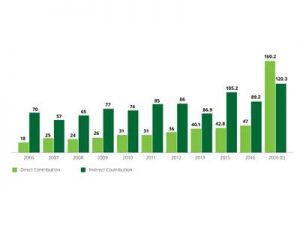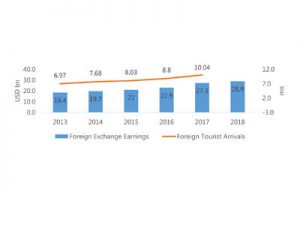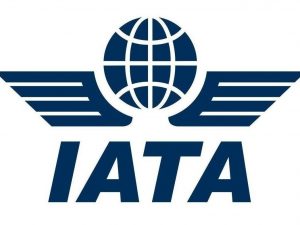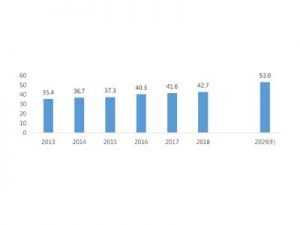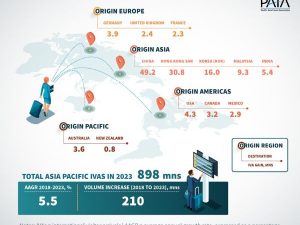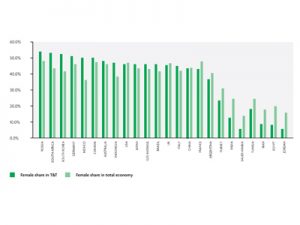The latest issue of the UNWTO World Tourism Barometer from the World Tourism Organisation shows that international tourism continued to grow over the first quarter of 2019. Though at a slower rate when compared with the last two years, the 4% increase registered in early 2019 is a very positive sign. The Middle East (+8%) and Asia Pacific (+6%) experienced the highest increase in international arrivals. Numbers in both Europe and Africa were up by 4%, and in the Americas growth was recorded at 3%. “International tourism continues to perform strongly worldwide fuelled by a positive economy, increased air capacity and visa facilitation”, says UNWTO Secretary-General, Zurab Pololikashvili. “Growth in arrivals is easing slightly after two years of exceptional results, but the sector continues to outpace the global rate of economic growth.” Europe, the world’s largest tourism region, reported solid growth (+4%), led by destinations in Southern and Mediterranean Europe and Central and Eastern Europe (both +5%). Growth in Africa was driven by the ongoing recovery in North Africa (+11%). In the Americas, the Caribbean (+17%) rebounded strongly after weak results in 2018, following the impact of hurricanes Irma and Maria in late 2017. In Asia and the Pacific, results for the first three months showed a 6% increase led by North-East Asia (+9%) and a very solid performance from the Chinese market. “With this growth comes greater responsibility for translating it into better jobs and better lives”, Pololikashvili stresses. “We need to continue investing in innovation, digital transformation and education so that we can harness the many benefits tourism can bring while at the same time mitigating its impact on the environment and society with a better management of …
Read More »Tourism to contribute $280 billion to Indian GDP by 2026
The total contribution of travel and tourism to Indian GDP is forecasted to increase by 4.97 per cent per annum to $280.5 billion by 2026, according to a recent report commissioned by Confederation of Indian Industry (CII) and Deloitte. The value of the restaurant and hotel industry is expected to continue to grow at a rate (averaging 8.1% annually throughout the forecast period), as India seeks to develop and diversify the types of tourists served. Its value will increase to $39.8 billion by 2020. While the hotel and restaurant industry contributes less than 1.5% of GDP–a share that will be maintained in the next five years—this merely attests to the diversity and strength of other industries, such as IT, mining and infrastructure, which remain very important to the economy.
Read More »Foreign Exchange Earnings from tourism in India to increase by 6.8% in 2019
Foreign Exchange Earnings (FEE) from tourism stood at USD 28.9 billion (INR 1.97 trillion) in 2018, which accounted for 5.4 per cent of the total exports, according to a latest FICCI-Yes Bank report. The contribution is further expected to increase by 6.8 per cent in 2019 and rise by 5.6 per cent p a by 2029 to reach INR 3.63 trillion. However, India ranks 14th in terms of absolute FEE and 122nd in terms of share of visitor exports in total export. India is also the third largest globally in terms of investment in travel & tourism with an investment of USD 45.7 billion (INR 3.12 trillion) in 2018, accounting for 5.9 per cent of national investment. This is expected to increase by 9.4 per cent in 2019 to INR 3.42 trillion, and further rise by 7.4 per cent p a till 2029, taking the share in national investment to 6.1 per cent.
Read More »India’s domestic market registers a meagre 3% growth in March 2019 against last year
The International Air Transport Association (IATA) has declared that India’s domestic market rose just 3.1 per cent in March, down from February’s growth of 8.3 per cent. These figures were part of the global passenger traffic results for March 2019, released by IATA, which shows that demand (measured in revenue passenger kilometers, or RPKs) rose 3.1 per cent, compared to the same month a year ago, which was the slowest pace for any month in nine years. The numbers are way against the scorching five-year average growth pace of close to 20 per cent per month.The slowdown comes in line with the reduction in flight operations of Jet Airways, which stopped flying in April, as well as disruptions at Mumbai airport owing to construction.
Read More »HRANI to hold its next conclave in Ludhiana on 27 May
HRANI’s next conclave has been scheduled for Monday, May 27, 2019 in Ludhiana, Punjab at 1800 hrs onwards. The conclave will be inaugurated by Chief Guest, Pawan Agarwal, Chief Executive Officer, Food Safety and Standards Authority of India (FSSAI). The conclaves are planned and organised by HRANI in all nine state of North India on rotation basis. The last conclave held in Uttar Pradesh’s capital, Lucknow, themed on the Environmental Concerns of Hospitality Industry witnessed participation in good numbers. The sessions captivated the audience and a Guide for Waste Management in Hospitality Industry was launched during the last HRANI Conclave. This time, Hotel and Restaurant Association of Northern India (HRANI) in collaboration with Hotel & Restaurant Association of Punjab (HRAP) has planned to introduce ‘HRANI Awards – Ludhiana Edition’. The awards have been instituted by HRANI to encourage industry professionals and recognize excellence, in the hospitality industry. More information can be found on HRANI’s website about the awards. The session on Hygiene Rating is planned with the aim to sensitize hoteliers and restaurateurs about the various benefits of the rating system. Apart from that, knowledge drive presentation on re-purposing used cooking oil into bio-diesel and FSSAI’s Hygiene Rating initiative are planned in the interest of the hotel and restaurant members. Start-ups such as BioD have initiated the repurposing of used cooking oil with the objective to create sustainable solutions for a greener environment and a healthier society. The knowledge will highlight the harmful effects of consuming cooking oil which is used and re-used.
Read More »Younger travellers are spending longer in a given destination: CAPA-Expedia report
Group packages to Europe traditionally covered five to eight destinations within a couple of weeks. However, millennial travellers are expressing a preference for visiting fewer destinations on a single trip, reports a study by CAPA India and Expedia titled ‘The Inflection Point for Indian Outbound Travel’. There are two drivers to this. Firstly, a desire to better discover and experience the places visited. This is supported by the increasing affordability of travel which means that people believe that they will have the opportunity to travel again in future, rather than a trip being a once-in-a-lifetime event where they need to tick multiple destinations off a list. Secondly, travel is increasingly seen as a means to rejuvenate and recharge and hence more leisurely itineraries are preferred.
Read More »Tourism to provide employment to nearly 53 million people in India by 2029
Travel and tourism is expected to provide employment to nearly 53 million people in India, directly and indirectly, by 2029, as per a latest report on inbound tourism commissioned by FICCI and Yes Bank. The sector has been a key source of employment as well, directly accounting for 26.7 million jobs in 2018. Further, the total jobs from indirect and induced activity stood at 42.7 million. The number is estimated to reach 43.7 million in 2019, accounting for 8.1% of the total employment in the country.
Read More »India’s golf tourism revenue to double by 2021: Peter Walton
With international tourists expected to grow in the next few years, it is important that India has the right product to meet the need of the visitors. Peter Walton, President and Chief Executive, International Association of Golf Tour Operators (IAGTO), says, ‘India is an incredible kaleidoscope of destinations and experiences and so are the golf courses. I can see doubling of golf tourism revenue in India by 2021. India is still an undiscovered golf destination, even though you have 230 golf courses. Through golf, visitors will be able to experience India. 70 per cent of golf travellers are looking for a unique place which they ahev not discovered earlier.” Sharing statistics on the value of the market he adds, “Since the global economic crisis in 2008-2009, that impacted the entire leisure industry, golf bounced back within 18 months to two years, because golfers will not be denied their annual golf travel fix. Since 2011, golf tourism has grown every year at a rate between 8 and 10 per cent. So, on an average double the rate of growth of an average leisure tourism which is about 4 per cent. That carried on until 2018, we actually anticipate now that the rate of growth will slow to 5-7 per cent per year for the next three years. Mainly due to the lack of sufficient golf courses of a suitable standard in destinations people want to travel to. So, demand is still there but supply in the most popular destinations at the most popular time of the year is insufficient to cope with the demand. That is why new destinations like India can really advantage of the strong situation in the market.”
Read More »5.4 million more Indians to visit Asia Pacific by 2023: PATA
India is set to generate an incremental increase of 5.4 million visitor arrivals between 2018 and 2023, according to a latest report by PATA’s Asia Pacific Visitor Forecasts 2019-2023. Of the 210 million additional foreign arrivals into Asia Pacific generated between 2018 and 2023, 73.7 per cent will come from Asian origin markets. The strongest Asian generators of additional visitor arrivals between 2018 and 2023 will be led by China and Hong Kong SAR with respective increases of 49.2 million and 30.8 million. These markets will be supported by Korea (ROK), Malaysia and India. The Asian Average Annual Growth Rate for tourism receipts between 2018 and 2023 is expected to be around 9.1 per cent, with Northeast and Southeast Asia showing even stronger average growth. “The growth momentum of Asia Pacific as both a receiver and a generator of international visitors – not just into Asia Pacific but globally – and the receipts that they both receive and generate, is set to continue to at least 2023,” said Dr Mario Hardy, CEO, PATA. “As is always the case, growth in international arrivals across Asia Pacific and indeed globally, is often unequal, with subtle changes and shifts occurring as travellers tune into new experiences and the destinations that offer them,” he said.
Read More »Women account for 12% of travel and tourism’s employment in India: WTTC
The female share of employment in tourism in India accounts for 12.1 per cent, according to a latest report by World Travel and Tourism Council (WTTC) titled ‘Travel & Tourism: Driving Women’s Success.’ There could be an 11 per cent increase in global GDP if every country achieved the fastest rate of progress in its region on closing the three key gender gaps of workforce participation, the report states. Travel and tourism can provide women with more opportunities for workforce participation, leadership, entrepreneurship and empowerment than many other sectors, particularly in developing countries and as such it can have a tremendous effect on poverty reduction in rural communities. At the macro level, a stronger representation of women in travel and tourism relative to other areas of economy is due to the sector’s unique characteristics: often less emphasis on formal education and training, greater emphasis on personal and hospitality skills, flexible working opportunities, and increased options for entrepreneurship that do not require heavy start-up financing. While there are wide variations in gender equality by region, socio-economic class, ethnicity and age, women’s labour force participation rates are gradually approaching those of men in many developed countries, supported by public policies including family support, rights to paid leave, and affordable childcare services for working mothers. Women also have some of the highest rates of participation in developing countries, reflecting economic necessity.
Read More » Tourism Breaking News
Tourism Breaking News

